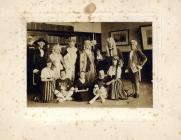Gellir lawrlwytho cynnwys at ddefnydd anfasnachol, megis defnydd personol neu ar gyfer adnoddau addysgol.
Ar gyfer defnydd masnachol cysyllwch yn uniongyrchol gyda deilydd yr hawlfraint os gwelwch yn dda.
Read more about the The Creative Archive Licence.
Disgrifiad
The old Town Hall referred to in the Machynlleth Borough Guide was a handsome stone building with a central arch entranceway, two arch- windowed shops on either side, and five windows, one with a balcony, at second storey height. The upper floor contained a theatre, with stage and balcony seats. It was built in 1873 by a prominent group of local people who also created the Town Hall Company to operate the premises. However, by 1900, the company was in financial difficulties with a mortgage on the property being in the process of being called in. The Directors had to organise a loan to keep the premises operating. By 1907, the situation had worsened and the company was voluntarily wound up. Negotiations were entered into with the Urban District Council with a view to the building being purchased for various public events, but these were unsuccessful. It was placed for sale by public auction and purchased for £1295 by Mr Edward Breese, grocer. Although a year later, it was bought by the Council. This fine Victorian building was ultimately demolished in 1968.
Previous to this Town Hall, a medieval market hall has stood at the junction of Heol Maengwyn Street, Hoel Penyrallt Street and Heol Pentrerhyden. Sir William-Watkins demolished this and built a new hall on the site in 1783. Stalls were provided on the ground floor, with the first floor used for meetings of manorial and magistrates courts.
On 1 November 1854, George Burrows on his tour of Wales met an attorney preparing to defend a tenant of Lord Vane accused of spearing fish belonging to Sir William Watkins. Burrows’ curiosity was piqued when he met the felon - ‘a small, mean, wizzened-faced man of about sixty, dressed in a black coat and hat, drab breeches and gaiters, and looking more like a decayed Methodist preacher than a spearer of imperial salmon’. Burrows subsequently attended the trial upstairs in this building and immortalised the attorney and his client in his work, Wild Wales, published 1862.
Follow this link to read the full text of Wild Wales online:
http://ebooks.adelaide.edu.au/b/borrow/george/wild/chapter78.html
A weekly market has been held in Machynlleth since 1291, drawing farmers and craftsmen from the surrounding valleys and mountains to sell their produce. These included the porthmyn (sheep and cattle drovers), tanners, wool-staplers and sellers of traditional Welsh cloth (brethyn). A document dated 1632 reveals that animals for sale came from all over Merionethshire, Montgomeryshire, Cardiganshire, Carmarthenshire and Denbighshire, with prospective buyers coming from Flintshire, Radnorshire, Brecknockshire, Herefordshire and Shropshire, in addition to the above. Around 1900, there were 15 annual fairs, not counting the Christmas Fair. Four were for sheep only. Cattle were sold at 8 fairs and horses at 9 fairs. Many of these sheep and cattle were destined for the Smithfield market in London after three weeks of walking the traditional drove roads. The last Welsh porthmyn were David Isaac and John George from Ceredigion. Both did business at Machynlleth market between 1911 – 1932. Their sheep were driven from pens near Pont-ar-Ddyffi to Aberhonddu (Brecon).
The town still comes alive on Wednesday, market day, particularly when the sun is shining and it is possible to sit outside the excellent cafes.
To see an historic view of Heol Penyrallt with the old Town Hall and Market Building on the right hand side, follow this link:
http://www.peoplescollectionwales.co.uk/items/17972
To see an historic view of the original Town Hall that George Burrows wrote about, follow this link:
http://www.peoplescollectionwales.co.uk/items/32873






Oes gennych chi wybodaeth ychwanegol am yr eitem hon? Gadewch sylwad isod
Sylwadau (0)
Rhaid mewngofnodi i bostio sylw